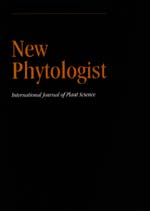Crossref Citations
This article has been cited by the following publications. This list is generated based on data provided by
Crossref.
Ollerenshaw, J.H
and
Lyons, T
1999.
Impacts of ozone on the growth and yield of field-grown winter wheat.
Environmental Pollution,
Vol. 106,
Issue. 1,
p.
67.
Zheng, Youbin
Lyons, Tom
and
Barnes, Jeremy
2000.
Effects of ozone on the production and utilization of assimilates in Plantago major.
Environmental and Experimental Botany,
Vol. 43,
Issue. 2,
p.
171.
Donnelly, Alison
Jones, Mike B
Burke, James I
and
Schnieders, Bert
2000.
Elevated CO2 provides protection from O3 induced photosynthetic damage and chlorophyll loss in flag leaves of spring wheat (Triticum aestivum L., cv. ‘Minaret’).
Agriculture, Ecosystems & Environment,
Vol. 80,
Issue. 1-2,
p.
159.
Ewert, Frank
and
Porter, John R.
2000.
Ozone effects on wheat in relation to CO2: modelling short‐term and long‐term responses of leaf photosynthesis and leaf duration.
Global Change Biology,
Vol. 6,
Issue. 7,
p.
735.
Gelang, Johanna
Pleijel, Hakan
Sild, Ebe
Danielsson, Helena
Younis, Suhaila
and
Sellden, Gun
2000.
Rate and duration of grain filling in relation to flag leaf senescence and grain yield in spring wheat (Triticum aestivum) exposed to different concentrations of ozone.
Physiologia Plantarum,
Vol. 110,
Issue. 3,
p.
366.
Gelang, Johanna
Pleijel, Håkan
Sild, Ebe
Danielsson, Helena
Younis, Suhaila
and
Selldén, Gun
2000.
Rate and duration of grain filling in relation to flag leaf senescence and grain yield in spring wheat (Triticum aestivum) exposed to different concentrations of ozone.
Physiologia Plantarum,
Vol. 110,
Issue. 3,
p.
366.
Lawson, Tracy
Craigon, J.i.m.
Tulloch, Ann-Marie
Black, Colin R.
Colls, Jeremy J.
and
Landon, Geoff
2001.
Photosynthetic responses to elevated CO2and O3 in field-grown potato(Solanum tuberosum).
Journal of Plant Physiology,
Vol. 158,
Issue. 3,
p.
309.
Kleier, C
Farnsworth, B
and
Winner, W
2001.
Photosynthesis and biomass allocation of radish cv. “Cherry Belle” in response to root temperature and ozone.
Environmental Pollution,
Vol. 111,
Issue. 1,
p.
127.
Donnelly, Alison
Craigon, Jim
Black, Colin R.
Colls, Jeremy J.
and
Landon, Geoff
2001.
Does elevated CO2 ameliorate the impact of O3 on chlorophyll content and photosynthesis in potato (Solanum tuberosum)?.
Physiologia Plantarum,
Vol. 111,
Issue. 4,
p.
501.
McKee, I. F.
and
Long, S. P.
2001.
Plant growth regulators control ozone damage to wheat yield.
New Phytologist,
Vol. 152,
Issue. 1,
p.
41.
Vorne, V
Ojanperä, K
De Temmerman, L
Bindi, M
Högy, P
Jones, M.B
Lawson, T
and
Persson, K
2002.
Effects of elevated carbon dioxide and ozone on potato tuber quality in the European multiple-site experiment ‘CHIP-project’.
European Journal of Agronomy,
Vol. 17,
Issue. 4,
p.
369.
Pell, Eva J.
Miller, Jennifer D.
and
Bielenberg, Douglas G.
2004.
Plant Cell Death Processes.
p.
295.
del Valle-Tascon, S.
and
Carrasco-Rodriguez, J. L.
2004.
Production Practices and Quality Assessment of Food Crops Volume 1.
p.
189.
Kanerva, Teri
Regina, Kristiina
Rämö, Kaisa
Karhu, Kristiina
Ojanperä, Katinka
and
Manninen, Sirkku
2005.
Mesocosms Mimic Natural Meadows as regards Greenhouse Gas Fluxes and Potential Activities of Nitrifying and Denitrifying Bacteria.
Plant and Soil,
Vol. 276,
Issue. 1-2,
p.
287.
Wahid, A.
2006.
Influence of atmospheric pollutants on agriculture in developing countries: A case study with three new wheat varieties in Pakistan.
Science of The Total Environment,
Vol. 371,
Issue. 1-3,
p.
304.
Marco, F.
Calvo, E.
Carrasco, P.
and
Sanz, M. J.
2007.
Analysis of molecular markers in three different tomato cultivars exposed to ozone stress.
Plant Cell Reports,
Vol. 27,
Issue. 1,
p.
197.
Wang, Xiaoke
Zheng, Qiwei
Yao, Fangfang
Chen, Zhan
Feng, Zhaozhong
and
Manning, W.J.
2007.
Assessing the impact of ambient ozone on growth and yield of a rice (Oryza sativa L.) and a wheat (Triticum aestivum L.) cultivar grown in the Yangtze Delta, China, using three rates of application of ethylenediurea (EDU).
Environmental Pollution,
Vol. 148,
Issue. 2,
p.
390.
Xu, H.
Biswas, D. K.
Li, W. D.
Chen, S. B.
Zhang, L.
Jiang, G. M.
and
Li, Y. G.
2007.
Photosynthesis and yield responses of ozone-polluted winter wheat to drought.
Photosynthetica,
Vol. 45,
Issue. 4,
p.
582.
Leitao, L.
Bethenod, O.
and
Biolley, J.‐P.
2007.
The Impact of Ozone on Juvenile Maize (Zea mays L.) Plant Photosynthesis: Effects on Vegetative Biomass, Pigmentation, and Carboxylases (PEPc and Rubisco).
Plant Biology,
Vol. 9,
Issue. 4,
p.
478.
Black, V. J.
Stewart, C. A.
Roberts, J. A.
and
Black, C. R.
2007.
Ozone affects gas exchange, growth and reproductive development in Brassica campestris (Wisconsin Fast Plants).
New Phytologist,
Vol. 176,
Issue. 1,
p.
150.

